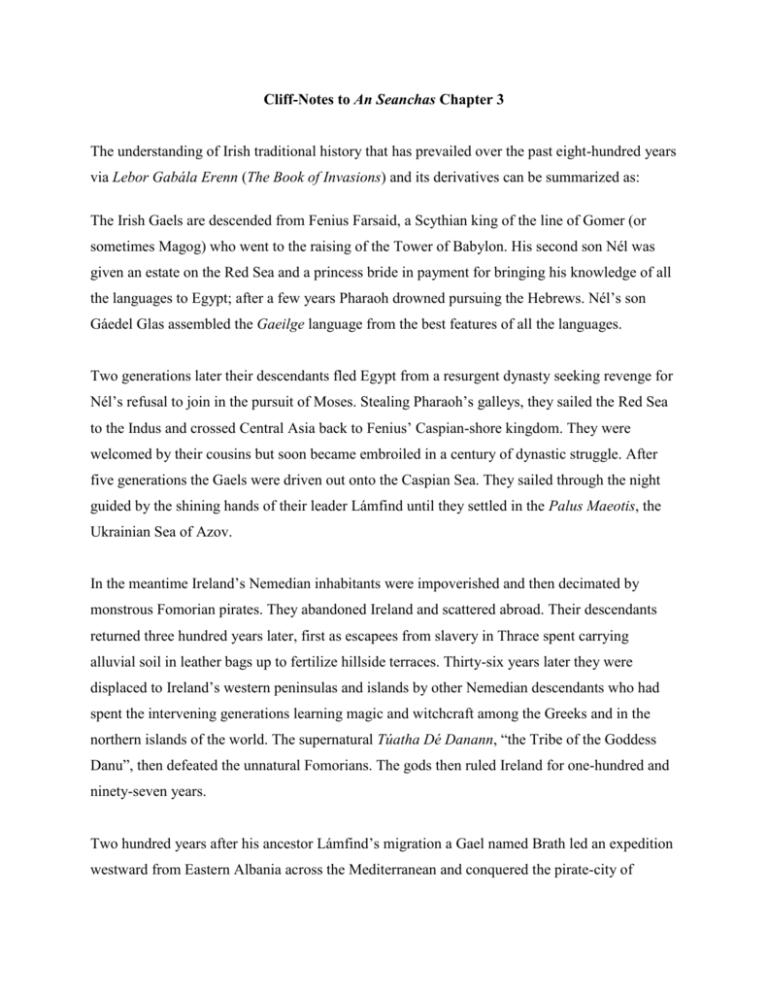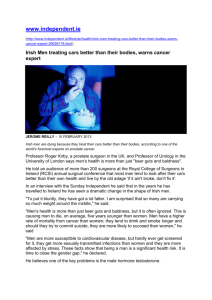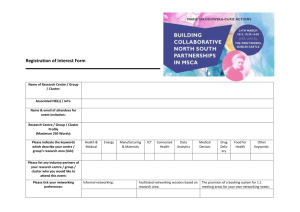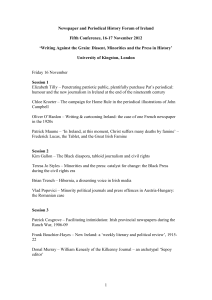
Cliff-Notes to An Seanchas Chapter 3
The understanding of Irish traditional history that has prevailed over the past eight-hundred years
via Lebor Gabála Erenn (The Book of Invasions) and its derivatives can be summarized as:
The Irish Gaels are descended from Fenius Farsaid, a Scythian king of the line of Gomer (or
sometimes Magog) who went to the raising of the Tower of Babylon. His second son Nél was
given an estate on the Red Sea and a princess bride in payment for bringing his knowledge of all
the languages to Egypt; after a few years Pharaoh drowned pursuing the Hebrews. Nél’s son
Gáedel Glas assembled the Gaeilge language from the best features of all the languages.
Two generations later their descendants fled Egypt from a resurgent dynasty seeking revenge for
Nél’s refusal to join in the pursuit of Moses. Stealing Pharaoh’s galleys, they sailed the Red Sea
to the Indus and crossed Central Asia back to Fenius’ Caspian-shore kingdom. They were
welcomed by their cousins but soon became embroiled in a century of dynastic struggle. After
five generations the Gaels were driven out onto the Caspian Sea. They sailed through the night
guided by the shining hands of their leader Lámfind until they settled in the Palus Maeotis, the
Ukrainian Sea of Azov.
In the meantime Ireland’s Nemedian inhabitants were impoverished and then decimated by
monstrous Fomorian pirates. They abandoned Ireland and scattered abroad. Their descendants
returned three hundred years later, first as escapees from slavery in Thrace spent carrying
alluvial soil in leather bags up to fertilize hillside terraces. Thirty-six years later they were
displaced to Ireland’s western peninsulas and islands by other Nemedian descendants who had
spent the intervening generations learning magic and witchcraft among the Greeks and in the
northern islands of the world. The supernatural Túatha Dé Danann, “the Tribe of the Goddess
Danu”, then defeated the unnatural Fomorians. The gods then ruled Ireland for one-hundred and
ninety-seven years.
Two hundred years after his ancestor Lámfind’s migration a Gael named Brath led an expedition
westward from Eastern Albania across the Mediterranean and conquered the pirate-city of
Briganza (modern A Coruŋa) at the northwest-tip of the Iberian peninsula (Galiza). His son
Breogán built a tower there, from which his grandson Íth saw Ireland on a winter’s eve. Íth
traveled to Ireland. Fearing that Íth coveted Ireland the Danann kings killed him, but his son and
followers escaped to report his murder.
Íth’s nephew Míl had retraced his ancestors’ route between Scythia and Egypt as a mercenary
and adventurer, taken an Egyptian princess bride, retraced his journey and returned to die at
Briganza. Míl’s sons led an invasion of Ireland. The Gaels defeated the magical Túatha Dé
Danann and drove them underground where they evolved into the fairies of the mounds. The
Gaels took the rule of the half of Ireland above ground.
Earlier versions of the tale that survive as poems and a single Irish World-Chronicle epitome are
far less mythologized and tell a somewhat different story. This document corrects some of the
misunderstandings that were incorporated into and obscure the original sense. The restored Irish
proto-history seems to preserve authentic Bronze-Age memories that precisely fit the geography
and chronology of their contemporary genetic, linguistic, cultural and technological millieu.
The pre-70 A.D. Biblical commentary Liber Antiquitatum Biblicarum places a Feneth son of
Dodanim (whose descendants “were scattered abroad and dwelt on the earth among the Persians
and Medes and in the islands that are in the sea”) at the Tower. Feneth appears to be cognate
with Fenius Farsaid, the Gaelach patriarch. Duan Eireannach placed his homeland at “the border
of Scythia… on the straits of the Caspian Sea… the stream to the corona in front of the Muddy
Sea”. Lebor Gabála Erenn identified the place as “the shielding arm of Scythia”, “the bright
shield of Scythia” and “the speckled shield of Scythia”. The Turkish word for ‘speckled’ is
aladzha and Amu Darya means ‘Muddy Sea’. Fenius’ principality appears to have been the port
of Aladzha on the shielding arm of Khazar Island at the ancient Uzboi Channel Caspian outfall
of the Amu Darya.
Linguistic and genetic evidence accommodate that location. Gaeilge is a Centum language that is
distinguished by many archaic conventions characteristic of the Indo-European language spoken
in Central Asia in the Middle Bronze Age. The Y-DNA signature of the HG1 Atlantic Modal
Haplotype and particularly the Gaelach Irish clearly reflects founder effect. It is descendent from
Caucasian and Central Asian predecessors. HG1 accounts for 52% of Turkmenistani Y-DNA.
Nél son of Fenius was recruited to Egypt by a “company of dark-blue adornments”, a detail that
identifies them with an Amun dynasty. Lebor Gabála Erenn synchronized to LAB places Fenius
in Babylon in the time of Hammurabi and Nél in Egypt contemporary with the Hyksos
overthrow of the Amun Thirteenth Dynasty.
Gaeilge was legendarily assembled in Egypt by Nél’s son. It is marked by unexplained AfroAsiatic features (V-S-O syntax, for example) that are best explained by close geographic contact.
The Irish accounts say that the Gaels fled Egypt ahead of the revenge of Pharaoh Tuir. Seqenenra
Taa (Tao the Brave) was the re-emergent Amun pharaoh who began the expulsion of the Hyksos.
By Egyptian and Irish chronologies Taa and Tuir are nearly contemporary. Taa was unknown to
Manetho, so if Tuir meant Taa the identification is not possibly a Christian-era embellishment.
Irish accounts say that the Nemedians abandoned Ireland at about the same time. They say that
Ireland was deserted for three hundred years until the return of the Fir Bolg and Túatha Dé
Danann. In the Irish archaeological record the Collared and Cordoned Urn burial traditions
disappear about 1500 B.C. followed by three centuries that left few artifacts.
The Gaels were driven off the Speckled Shield of Scythia “with a point”. Altai-inspired hollowcast socketed bronze spearheads were beginning to spread westward during the same period,
replacing stone and bone spearheads. Candles lit their way; aladzha wax a valuable trade article.
The Irish origin story describes their flight south on the Caspian Sea past the Caucasus to
“Eastern Albania”, Golgatha gaethach (‘marshy Golgatha’) and Gaethlaigib Medontachda (‘the
Great Lagoon Touching Media’). Golgah/Gulgakh is a place at the middle of the corona
enclosing the vast Mordab-e-Anzali lagoon. It is in Guilan, the Iranian province bordering the
Caspian Sea, Eastern Azerbaijan (anciently Eastern Albania) province and Media (central Iran).
Strabo placed the Gelae there; Pliny called the inhabitants Gaëli and Ptolemy the Geloi;
modernly the Guils claim pre-Aryan ancestry. Dairy-cattle herders there are known as gālĕs as
opposed to the shepherd kord. “The sojourn in the marshes” clearly took place at Golgah on the
Anzali lagoon and not at the Sea of Azov.
The Fir Bolg returned to Ireland from “the Greeks’ rough sea-clay” at Inber Domnann (‘the
estuary of the Dumnonii’). Ptolemy identified the Dumnonii as the people of the tin-rich Fal river
estuary in Cornwall (Old Irish du Brethnaib Corn, ‘the Horn of the Carrying’). The invaders are
the Fir Domnann “great estuary excavators”, the Gaileóin (Gall-Ionnai, ‘Ionian Foreigners’)
spearmen and the Fir Bolg (‘Men of Bags’). The Medieval arms of the Cornish Faull family
depict bouget, bags suspended from a yoke for carrying cassiterite “stream tin”. The Fir Bolg
slavery clearly took place at Falmouth in Cornwall. Tracia was probably contracted from Tráacían, ‘ocean-strand’ and never meant Thrace.
In Ireland the immigrants did not prosper. The rule passed from the Gaileóin to the Fir Domnann
to the Fir Bolg. Eochu son of Rinnáll (‘stone spearhead’) became king and the first man in
Ireland to be killed by a spear-point. In Irish literature the Túatha Dé Danann, “the people of
ships and of drinking beakers”, are said to have brought metal spear-points to Ireland and
defeated the Fir Bolg and Fomorians because they wielded lighter, sharper, more durable
weapons that could be repaired overnight. Bronze spearheads archaeologically appear in Ireland
in the same era.
The Túatha Dé Danann share the same ancestry as the Fomorians that they fight. The pirates’
description as “men with single arms and single legs” never meant to portray monsters but
maimed and crippled men driven to piracy by their handicaps, exactly like the peg-legged
buccaneers of the Caribbean (the first-mentioned Fomorian was Cichol Clapper-leg).
Their common ancestor was Indui, “lord of the horse-breeding people”. Elites that traded gelding
horses and scrupulously guarded monopolies on stallions and mares were the aristocracy of the
era; as the Bible records regarding the Philistines, metal-working societies enforced similar
control over the proliferation of bronze weapons and even tools.
Túatha Dé Danann does not mean “the Tribe of the Goddess Danu” (Túatha Ban-Dia Danann).
There is no woman named Danu in the manuscripts, although Áine the well-deity is sometimes
called Anand. A Danann woman named Dianann or Danand should not be deified by reference to
her sons as trí nDee mistranslated to mean “the three Gods”. Their sobriquet meant “the three of
the Dee” referring to their Sliab nDee stronghold at Glendalough, “the glen of the lake of the
River Dee”, from where ndee n-airchelta (‘the plunderers of the Dee’) controlled the metal-rich
Avoca River valley. The name of Dianann’s sister Argoen is far more significant.
Túatha Dé Danann is accurately translated as ‘the Sacred Tribe of Dana’, cognate with the
appellation “the Sacred Race of the Danaoi” that the Greeks used to describe the Mycenaean
heirs to Danaus of Argos (which also accommodates an association with Áine; Danaus’
daughters the fifty Danaïdes were condemned to an eternity of drawing well-water into leaking
jugs). Josephus began the reign of Danaus three-hundred and ninety-three years after Exodus,
almost exactly contemporary with the arrival of the Túatha Dé Danann by Irish chronology.
The association with a far-away trade network is not anomalous; the Irish chronology for the
appearance of the Laigin south of the Liffey coincides with the seizure of Mediterranean trade by
the Alexandrian Ptolomaeus Lagi (Ptolemy Soter; 323-283 B.C.) and his Lagian followers. The
Irish called Ptolemy Soter Lairge and Waterford Port Láirge.
Other ancient legends placed descendants of Danaus along the Atlantic coast of Iberia in the
same period. Greek legend claimed that Heracles came there to steal the cattle of Geríon. Galizan
legend asserts that Heracles buried Geríon under the tower at the port of A Coruŋa and that his
companion’s son Teucer founded Pontevedra. Strabo said that the Danaan Amphilochus
colonized the Minho River at the modern Galizan-Portuguese border; he placed the Heleni along
its northern shore. Galiza was significant because it was the epicenter of Atlantic-littoral tin
deposits, the most significant sources west of the eastern steppes. Most of the tin for bronze
manufacture used by Bronze Age civilizations had to be obtained from one extreme or the other.
The four talismans of the Danann reflect the trappings of a metal-working elite. Their bronze
rapier, cauldron and socketed spearhead chronologically fit the archaeological horizons defining
the arrivals of those technologies in Ireland. The earliest swords were elongated daggers, aptly
described in the name of the Fomorian Tethra’s sword Oma, meaning a bar or bolt. The cauldron
was the most significant advance in domestic technology since pottery, and judging by its Irish
association with a city called Muirias it may also have been understood as a key component to
the production of fabric colored with ultra-valuable Murex dye. Irish cauldron designs have
Greek precedents.
That the “spear of Assal” plundered by the trí nDee was a socketed-spearhead is clear because it
returned to its leather sheath; flat spearheads were fixed onto their shafts. (Another labor of the
sons of Dianann was to recover the hide-wrapped hoard of the smith of the king of Fal from the
bog where it was hidden; mistranslation presented this task as the abduction of a whelp that
turned to a sheep by night and water thrown on it would turn to wine. The corrected passage
stands as literary testimony to hoard-deposition that is otherwise only archaeologically known.)
The fourth talisman was the Lia Fal, the stone of Fal that was carried to Ireland from Failias:
“Fál of the cove of the Dumnonii of the hostages from the north, that is, the stone that used to
roar vibrato when one took the kingship of Ireland.” When bent, tin emits a crackling “tin cry”.
The sobriquet of the celebrated smith Goibniu, engoba na Hiruaithi, means ‘the peerless smith of
the Ore-clay’. “Ore-clay” most likely describes cassiterite, the dull-grey alluvial grains of tin
found in tin-streams. ‘Uath’ ainm d’úir, diamhair an dath; ‘“Uatha” the name of ore, hidden the
brightness’.
The invention of the cipher-based Ogham (‘Scratching-time’; the fourth-century Scythian
Aethicus of Istria called it ideomochos, ‘chariot language’) alphabet by Oghma Cermait (‘Waxstick Scratching’; hinged wax daltu writing tablets are known from the thirteenth century) is
contemporaneous with the Aegean replacement of Linear B by the Canaan alphabet over the
course of the twelfth century B.C., legendarily carried there by either Danaus or his cousin
Kadmus of Tyre (along with the technologies for gold mining and bronze casting).
Ogham’s range of consonants is unlike those of Classical Greek or Latin. The Ogham consonants
most closely match those claimed for Greek before its legendarily-post-Troy Palamedian
modernization; fourteen of fifteen consonants match Graves’ purported early-Italic “Carmenta”
alphabet. Historic Irish had no Y Ŋ nGeadal, Z Z Straif orQ Q Ceirt. Ŋ, the eng/agma (ng/gn/nn)
may be significant to the dating of Ogham; it was dropped by the Palamedes alphabet but
survives in the name A Coruŋa (the –nn in Danann may also represent ŋ, phonetically
approximating Danaoi). Ogham appears to be just as ancient as Irish manuscripts say it is.
Míl’s journey from Fenius’ homeland to Egypt and back again via the Indus and Oxus Rivers
retraces the route of his ancestors. It takes place in and is plausible in the era of the Sea-Peoples
disruptions. It is significant that a poem attributed to Cenn Faelad (d. 679) employs Míl in the
defense of Egypt from sea-borne attack “at the western river-mouth shore”. The detail adds not
only a ring of authenticity but Libyan/Sea-Peoples attacks were commonly launched on the
western shore. Míl’s near-contemporary Pharaoh Ramesses III defeated three great Libyan and
Sea-Peoples invasions during his reign.
Míl’s overland route from the island of Irena at modern Constantinople back to A Coruŋa is very
different than Brath’s sea route west across the Mediterranean. He joined a host in Dacia that
plundered up into Gothia. The archaeological testimony of hoards and hillforts marks the mid12th century B.C. turmoil in Central Europe caused by sword-wielding eastern invaders.
The excerpted observations compiled above summarize what leads me to believe that the Irish
origin story and the traditions encompassing it contain chronologically accurate details that could
not have been invented by Medieval monks; they clearly preserve a genuine record of the events
that they claim to portray. Irish proto-history ought to be dusted off, re-opened and recognized as
a unique and invaluable tool in the study of Eurasian antiquity and the causes, chronology and
means of Indo-European language dispersal to Western Europe.
All rights reserved. No part of this document may be quoted, reproduced, stored in a retrieval system, or transmitted
in any form or by any means, electronic, electrical, chemical, mechanical, optical, photocopied, recorded or
otherwise prior to its publication without the prior written permission of the author.
Copyright 2007 Greg Noonan








